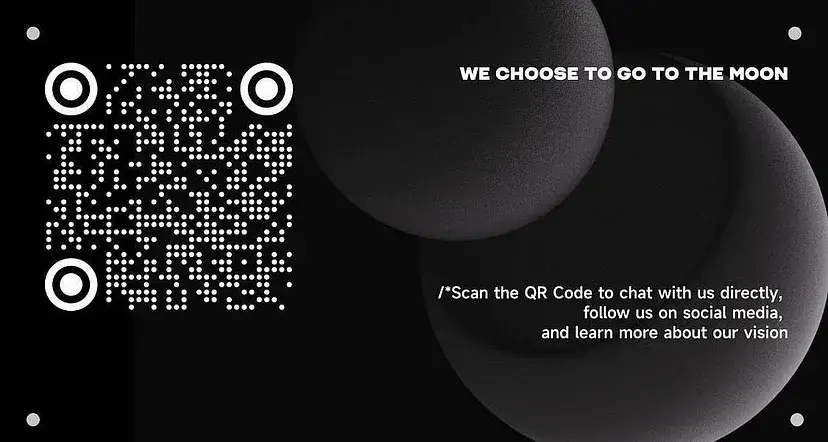Back
Moonshot Mafia #22 | Set the Foundation, HashKey Capital Portfolio Demo Day AMA
Fireside Chats
By Moonshot Commons
Dec 1,202325 min read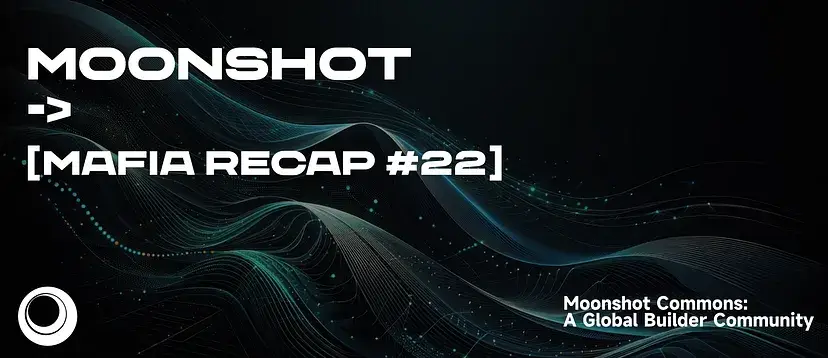
At Moonshot Commons’ Web3 Fireside Chat #22, HashKey Demo Day AMA, we invited speakers from leading infrastructure and middleware projects: Zooey, Co-founder and CEO of Dataverse; Mathew Sweezey, Chief Strategy Officer at Smart Layer; Burnt Banksy, Founder of Burnt (XION); Nicolas Biagosch, Co-initiator of the Q protocol; Mark Rydon, CEO and Co-founder of Aethir, and Greg, Chief Product Officer at ChainSafe.
HashKey Portfolio Demo Day is a showcase platform created by HashKey Capital for its portfolio of invested projects. It aims to help these projects connect with potential investors and partners within the ecosystem.
HashKey Capital is a leading institutional asset manager focused on blockchain technology and digital assets since 2015. They have a strong track record of investing in high-growth companies globally, with expertise in blockchain technologies. This vision and commitment ensure that it stands at the center of the blockchain ecosystem in Asia and globally. HashKey Capital’s portfolio covers a wide range of the blockchain ecosystem, including public chains, protocols, and applications across the globe. The team combines technological and financial market expertise, specializing in digital asset investment for institutional investors. (Visit HashKey Capital for more information)
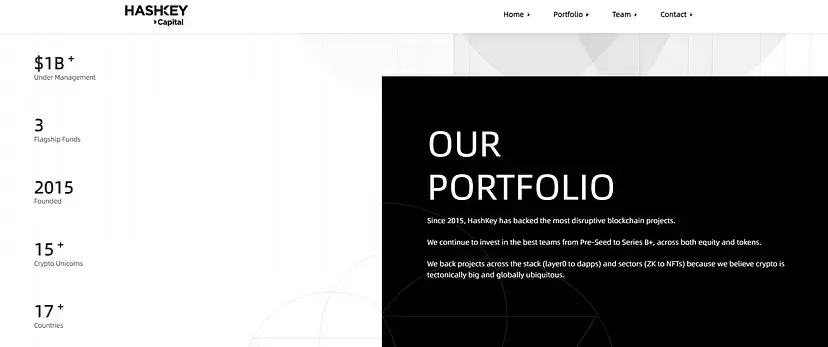
Source: HashKey Capital
Dataverse specializes in data infrastructure, empowering users with data ownership. Their platform, DataverseOS, serves as an internet data operating system that simplifies the creation of sovereign data apps.
Smart Layer is dedicated to developing toolsets for token-centric architectures. They offer Smart Pass, a growth-focused suite of tools that have successfully grown their community to over 2 million members in just 120 days.
Burnt (XION) aims to streamline the blockchain user experience with XION, serving as a modular Generalized Abstraction layer that abstracts away complexities like gas fees, cross-chain interoperability, and payments.
Q protocol pioneers a universal governance layer for the Web3 ecosystem. Q Protocol’s infrastructure accommodates complex governance decisions in a decentralized manner, eliminating the reliance on admin keys.
Aethir specializes in decentralized cloud infrastructure for the gaming and AI sectors. Aethir addresses the critical challenge of scaling low-latency, globally deployable GPU cloud solutions, essential for industries requiring resources for AI applications and cloud gaming.
ChainSafe stands out as one of the rare multi-chain research and development companies, playing a pivotal role in advancing the decentralized web.

Source: Moonshot Commons
Key Takeaways:
1.Web3 infrastructure is still in its early stages, presenting significant opportunities for innovation and growth.
2.Advanced technologies such as governance security and user-friendly experience are creating new avenues for business models and driving user adoption in the Web3 ecosystem.
3.Web3 infrastructure encompasses various untapped areas, such as gaming, where agile builders have the potential to make a significant impact as the ecosystem continues to evolve.
4.Middleware challenges, including standardization and seamless Web2-to-Web3 transitions, present collective hurdles for the Web3 industry to overcome.
5.Projects within the industry contribute unique innovations, ranging from data monetization to decentralized cloud infrastructure, thereby enriching the overall Web3 landscape.
6.Emerging Web3 projects actively seek partnerships and fundraising opportunities while the robust growth of Web3 project communities reflects the industry’s continuous expansion and evolution.

Moonshot Commons:
Welcome to the HashKey Demo Day AMA. Before we begin, I’d like to invite each speaker to briefly introduce themselves and provide an overview of their project to our audience.
Zooey:
Hello everyone, I’m Zooey, the co-founder and CEO of Dataverse. Our platform, DataverseOS, is a pioneering data infrastructure designed to give users ownership of their data. At its heart, it functions as an internet data operating system, simplifying the creation of sovereign data apps. It offers developers essential technical modules such as decentralized storage, data encryption, access control, and data monetization, which are the building blocks for a variety of applications — from content platforms and social networks to toolkits and dataset marketplaces for AI models.
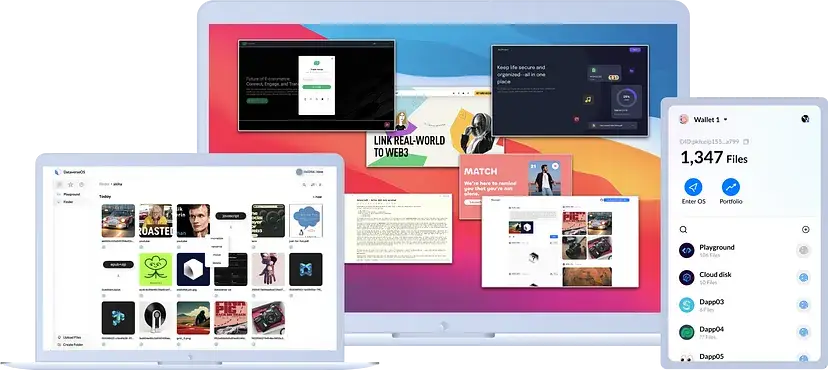
Source: Dataverse
DataverseOS also serves as a bridge for everyday users to enter the world of cryptocurrency. With multiple applications on our system, users can engage and generate data that is securely stored in their private space, linked to their wallets, and fully transferable across identities.
Our system enables users to take control of their data in an encrypted environment, equipping them with the tools to manage and monetize their information securely and efficiently.
Mathew:
I’m Mathew Sweezey, the Chief Strategy Officer at Smart Layer. We specialize in developing toolsets for creating token-centric architectures. Currently, we’re highlighting our newest offering, Smart Pass, a suite of growth tools designed to help Web3 projects expand.
We’ve successfully leveraged Smart Pass to grow our community to over 2 million members in just 120 days. We’ve also recently introduced an NFT to our community, which has garnered over $450,000 to date. We’re excited to collaborate with other projects that seek to tap into this potent growth mechanism to kickstart their ventures.

Source: Smart Layer
Burnt:
Hello everyone, I’m Burnt Banksy, the founder of Burnt. The inspiration for our name traces back to an unconventional event two and a half years ago when I purchased a Banksy artwork, set it ablaze, and then sold it as an NFT. Today, we’re at the forefront of innovation with XION, the first modular general abstraction layer designed to deliver frictionless experiences to users.
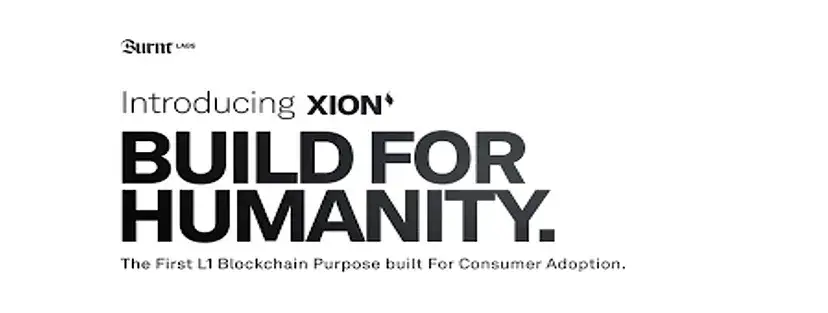
At Burnt, we’re pushing the boundaries beyond account abstraction. Our vision is to obscure the complexities of blockchain technology — everything from gas fees to cross-chain interoperability, pricing, devices, and payments. We aim to appeal to a Web2 audience by creating a user experience so seamless that they remain unaware they’re interacting with crypto products.
We’re currently operating on our live XION Testnet, which has seen an impressive uptake of just under 350,000 wallets in a little over a month. I’m looking forward to discussing the future of Blockchain and the Q protocol with you all.
Nicolas:
Hello, I’m Nicolas, co-initiator of the Q protocol. We’re pioneering a universal governance layer that provides shared governance security for the Web3 ecosystem. Imagine a system that transcends the limitations of transaction security, which, as you’re aware, ensures that coded transactions are secure and immutable.
More than 90% of critical business decisions are not binary or deterministic; they require nuanced interpretation, something beyond the scope of traditional coding. That’s where the Q protocol steps in, offering an infrastructure that accommodates these complex decisions in a fully decentralized way, effectively mitigating the risks of centralization prevalent in the DeFi space.
Our protocol allows for code upgrades without any admin keys, thereby eliminating the dangers of admin key centralization. We make system-critical decisions for DeFi, including determining eligible assets, in a completely decentralized manner. Additionally, we provide DAOs with the tools they need to establish a legal structure that includes a set of rules akin to a constitution, and we facilitate integration with the International Chamber of Commerce for dispute resolution.
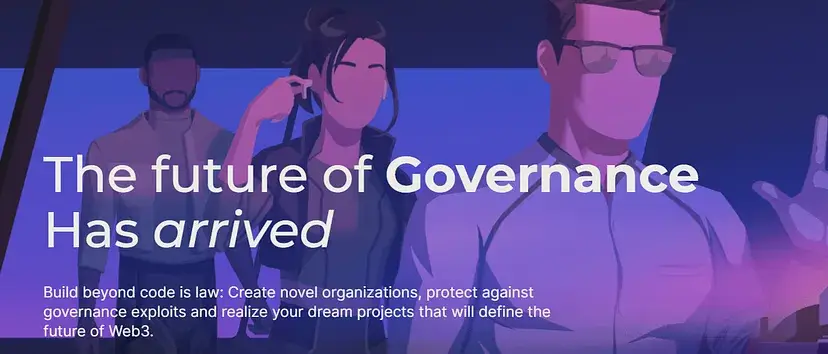
Source: Q protocol
We’re actively seeking partners to onboard and utilize these governance features, thereby securing an instant security upgrade. Whether it’s DeFi or DAOs, or any entity that manages code upgrades, our system is designed to remove the risk of admin keys.
Having been on the mainnet for one and a half years, we’re backed by several VCs, Deutsche Telekom, and supported by legal and academic experts from prestigious institutions including MIT and Stanford along with several European universities.
Mark:
I’m Mark, CEO and co-founder of Aethir. We’re at the forefront of creating a decentralized cloud infrastructure tailored for the gaming and AI sectors. At Aethir, we address a critical challenge: scaling low latency, globally deployable Graphic Processing Units (GPU) cloud solutions.
This is crucial because both emerging AI industries and established gaming giants require low-latency GPU resources to enhance their core technologies. Without an increase in these resources, we risk hitting a significant bottleneck that could hamper industry growth.
To put this into perspective, consider the vast amounts of capital being poured into AI training infrastructure since the AI surge earlier this year — billions invested. Yet, the question arises: what about the infrastructure for the application phase that follows AI training? The needs for training infrastructure and application infrastructure are distinct, and that’s the gap Aethir aims to bridge.
Aethir is creating the infrastructure that allows latency-sensitive services like AI applications, which are destined to be a core part of our future economy, to scale effectively in the cloud. Beyond AI, we’re also looking at transformative technologies such as cloud gaming. Aethir enables cloud-based gaming experiences that bypass the need for high-end hardware, potentially opening up the world of gaming to the 3 billion people without access to such equipment.

Source: Aethir
In essence, we’re constructing what we believe to be the vital decentralized cloud backbone for the gaming and AI industries of tomorrow.
Moonshot Commons:
I’d like to invite each of you to discuss how your projects are contributing to the scaling and application layers within the Web3 infrastructure, and what impact you foresee on the broader growth and evolution of Web3.
Mark:
Although Aethir might not fit the typical mold of Web3 scalability solutions, we leverage the Web3 application layer to enhance our Web2 infrastructure. To clarify, decentralized GPU cloud infrastructure, which is our specialty, is one of the few areas where Web3 inherently offers a scaling advantage over Web2.
Aethir’s core belief is that decentralized cloud infrastructure could benefit from the natural scalability of Web3, marrying it with the advantages of edge computing alongside traditional cloud benefits. This hybrid method establishes a robust infrastructure that exceeds current standards in Web3, and also redefines excellence in the Web2 realm. Our cloud solution, unique in its approach, offers unparalleled benefits, irrespective of individual perspectives on Web3.

Traditional Gaming vs. Cloud Gaming, Source: Aethir
This innovative infrastructure is attracting projects that hadn’t previously considered Web3 solutions, which leads to new possibilities. As we onboard more clients and users into this space, we’re excited to facilitate a transition that could significantly influence the adoption and growth of Web3.
Nicolas:
Our project, the Q Protocol, strengthens Web3 by enhancing security and decentralization. We focus on eliminating centralized components such as admin keys and centralized decision-making processes. Our innovation lies in enabling fully decentralized, non-deterministic decision-making.
This is crucial because most business decisions — upwards of 90 percent — are non-deterministic and require nuanced judgment. This has been a barrier for complex financial models, like insurance and pensions, to fully integrate with blockchain technology. With our governance security layer, we can support traditional business models transitioning onto the blockchain, fostering new decentralized opportunities in sectors like insurance, pensions, and more advanced DeFi systems.

Source: Q Protocol
Our infrastructure caters to applications and Layer 2 solutions, mitigating centralization risks and opening the door for sophisticated, decentralized business practices. This, in turn, paves the way for a new wave of business models to emerge and flourish in the decentralized ecosystem.
Burnt:
One of the core issues our industry faces, as you might imagine, is adoption. The reality is that we’re quite limited to users familiar with wallets and traditional crypto methods. We’ve inadvertently erected massive barriers to entry, which have stymied expansion beyond our current user base.
In terms of scaling, we’re addressing this from a consumer perspective by making it incredibly easy for developers to create applications that, to the end-user, feel like the Web2 experiences they’re comfortable with but are underpinned by a Web3 backend. This strategy is important as it allows us to expedite the adoption process and scale even further. Our approach isn’t merely about building infrastructure; it’s about reshaping the user experience to invite broader participation in Web3.
Mathew:
I love this question. Like Burnt said, our objective is to expand the ecosystem by welcoming more participants. Our Smart Pass system is designed to engage Web2 users with Web3 functionalities.
We’ve introduced a concept called questing, which allows users to earn points through a variety of channels and use those points to tailor experiences within the ecosystem. This approach shifts the focus towards mass onboarding, breaking down barriers to entry and making the transition to Web3 seamless and rewarding.
Our role in scaling is about community growth — we aim to facilitate a comfortable and intuitive connection for Web2 users to cross over into the Web3 space.

Source: Smart Layer
Zooey:
Pioneering the effort, we are essentially expanding the application layer to welcome more developers by simplifying their experience on the Web3 infrastructure. Dataverse harnesses a multitude of Web3 tech stacks, forming a unified data layer that’s integral for today’s privacy-focused and ownership-driven digital landscape.
By merging data networks with decentralized key management and accounts — think of protocols like ‘signing with Ethereum’ — we’ve crafted a private, user-centric storage solution. It’s designed to be incredibly intuitive, offering developers an out-of-the-box, powerful tool.
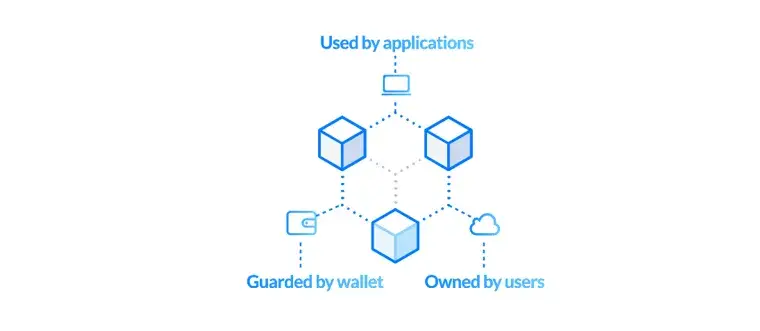
Source: Dataverse
We also allow users to regain control over their data. The Dataverse Cloud serves as a personal Omni Cloud drive, which overlays the application landscape. Here, data pods facilitate consensual data sharing, and enhance user experiences through personalization. Furthermore, our team constructs a universal indexing and curation protocol. We aim to organize and increase data value across Web3 applications and to strengthen the overall ecosystem.
Our key thesis moving forward is to make Web3 infrastructure more approachable and weave a network of applications that operate in harmony for the benefit of the entire community.
Moonshot Commons:
The next question is about the maturity of Web3 infrastructure. Recently, there’s a prevailing sentiment that the rapid maturation of Web3 infrastructure could potentially reduce opportunities for new entrants. What’s your take on this? Do you see room for innovation and new entrants in the infrastructure space?
Nicolas:
I have to disagree with that claim. When we take a hard look at the Web3 infrastructure landscape, it’s clear that we’re not dealing with a space that’s maturing and shutting doors on new players. We’re staring at gaps that are crying for innovation. Think about it: right now, our potential is hamstrung by what we can squeeze into deterministic code.
Now, here’s where it gets exciting — with what we’re bringing to the table, governance security, we’re not just tweaking existing models; instead, we’re opening the floodgates for a wave of new business models. And it’s not just about new opportunities; it’s about reinforcing our existing foundations, making them more robust, and stripping away the growth barriers.
Just imagine unlocking the next trillion-dollar layers of value in Web3 — and that’s no exaggeration. When it comes to the current infrastructure, let’s be real; we’re far from maxing out. Transaction security and scalability. We’ve been somewhat stagnant, not due to a lack of effort but because we’ve encountered a complex obstacle. It’s been a few months, perhaps even two years, of incremental rather than revolutionary progress.
To wrap it up, anyone who says we’ve hit peak maturity in Web3 infrastructure has it all wrong. We’re on the ground floor with an elevator that’s ready to soar — we just need to crack the right code.

Source: Forbes
Burnt:
I agree with Nicolas. The idea that we’ve hit some sort of maturity in the Web3 space just doesn’t hold water. We’re far from it, and frankly, the slowdown we’ve seen recently — even before the downturn, and throughout what was a bull market — is evidence of that. It’s exactly this rawness, this unrefined state of things, that’s got us all here today, discussing, debating, and innovating.
Let’s be real — the user onboarding experience in Web3? It’s a pain point. The overall user experience? Far from seamless. We’re grappling with these issues at every layer, which is both a challenge and an opportunity. It’s a paradox. If the ecosystem were perfect, this conversation wouldn’t be happening. None of us would be on this stage, pushing for progress.
This friction we’re facing, it’s the engine driving us all forward. So, while it’s frustrating, it’s also thrilling — because it’s not just about the problems we’re solving. It’s about the journey, the collective push towards a goal we’ve not yet achieved. That’s the exciting part — the process, the grind, the shared ambition. That’s what makes this space so dynamic and so ripe with possibility.
Mathew:
I’m going to double down and add my support to that last comment from Burnt. That’s exactly where we are. When we consider the timeline, history shows us that early entrants in a marketplace usually aren’t the ones to come out on top in the end. Take Facebook, for instance, it didn’t emerge until 2006, well after the dot-com crash in 2000. This suggests we’re years away from discovering the killer applications that define maturity in this sector.
Yes, we have solutions for the problems we’re aware of, but we’re only seeing a sliver of the Web2 world starting to engage with Web3. We haven’t even scratched the surface of understanding what their needs or problems might be, despite having some foundational infrastructure in place. In essence, we’re far from what could be considered mature in Web3.
And for those looking to innovate, a multitude of problems still need solutions. The existence of solutions doesn’t preclude improvement. If you can build something better, then absolutely go for it. So, in my view, we’re very early in the game.
Zooey:
I believe one of the biggest problems in today’s Web3 infrastructure is the lack of adoption. As a developer, the good old times have passed; we can’t just finish writing code and expect users and adoption to follow while comforting ourselves with the notion that Web3 is the future and the situation will improve as time passes. Such thinking doesn’t cut it anymore, especially in a bear market.,
We need to explore uncharted use cases like front-end technology and other innovative applications. From another perspective, the maturity of Web3 infrastructure offers greater opportunities for newcomers. The infrastructure is now more user-friendly, stable, and powerful than it was years ago. Developers have access to many infrastructure tools to check compatibility and create innovative combinations. This may set the path for fresh ideas and solutions.
We can’t deny that building a Web3 application is much easier today than it was five years ago. Web3 technologies are evolving towards a more user-friendly experience, a more scalable technical foundation, and an open infrastructure that empowers newcomers to build anything they want.

Source: Gemini
Mark:
We all agree that Web3 infrastructure is in its early stages. Building a Layer 1 or Layer 2 now needs a top-tier product, narrative, and team to stand out, which isn’t as easy as before. Infrastructure encompasses more than just layer ones, twos, and threes. I’m not stirring controversy by stating that much of Web3 hasn’t yet achieved product-market fit.
There have been numerous project failures, and that’s the nature of a bear market. However, this is a prime opportunity to learn from those failures. With case studies to analyze, we can enter the market with well-conceived solutions to the complex problems we’ve observed.
Consider the unexplored territories in Web3 such as gaming. It’s a trending space, but no Web3 game has broken into the mainstream — though we expect that to change soon. This breakthrough will trigger a wave of infrastructure projects to support a new cohort of gamers. It doesn’t make sense to build much of that infrastructure now without understanding their needs, but agile builders who can quickly adapt to service the first successful Web3 games will likely prosper.
In summary, we are still at a stage brimming with opportunities for learning and growth, and there is ample room for new builders to contribute and make a significant impact in Web3.
Moonshot Commons:
Greg, great to have you here. We’re discussing whether Web3’s fast growth limits newcomer opportunities. What’s your opinion, and do you think there’s still space for innovation and new entrants in the sector?
Greg:
Thanks for having me. At ChainSafe, we deal extensively with Web3 infrastructure through various software development kits (SDK). Currently, infrastructure is abundant, but there’s a race to zero in monetization which we see in remote procedure calls (RPC) and indexing services. Indexing, especially custom solutions, remains unsolved and unstable, affecting user experience, particularly in the gaming and NFT sectors.

Source: Chainsafe
The maturity of infrastructure development is progressing, yet existing solutions still lag in maturity. Interoperability remains critical, as highlighted by discussions on layer one, two, and three protocols.
However, the most glaring issue is developer experience (DevEx), which is notably underfunded. Despite advances, integration at the developer level is cumbersome; most time at hackathons is spent on documentation rather than actual development, a stark contrast to platforms like Firebase which offer quick and intuitive setups. This gap in usability and ease of integration is where the maturity of Web3 infrastructure truly falls short. We see this consistently, where developers struggle to understand and utilize these technologies effectively, and that’s where we need to focus on making improvements.
Moonshot Commons:
I want to leave some time to let Greg say hi to us as well and then give a self-introduction and product overview.
Greg:
I’m Greg, the Chief Product Officer at ChainSafe. I’ve been a developer in the space for quite some time, contributing to web3.js and initiating Lodestar, the Ethereum consensus client. At ChainSafe, my focus has been on creating interoperability, gaming, and ecosystem tools. ChainSafe is an R&D firm that conducts research and develops innovative solutions. Our core expertise has been in building consensus clients for platforms like Ethereum, Polkadot, and Filecoin, alongside developing developer tools such as web3.js and web3.unity. I’ll keep this brief so we can continue with our discussion.
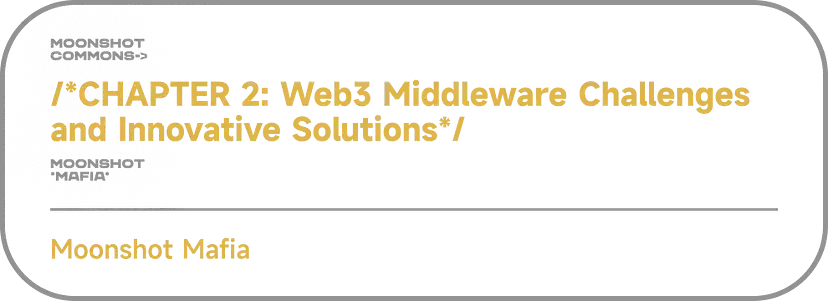
Moonshot Commons:
Regarding the middleware challenges, what are the critical issues that remain unsolved or might emerge as the infrastructure layer matures? How are you preparing to address these challenges?
Zooey:
I’ll focus on one point: standardization. There are numerous middleware solutions and protocols, and their number continues to grow. Establishing common standards and best practices is essential to enhance compatibility between systems and prevent fragmentation within the Web3 ecosystem.
Mark:
For us at Aethir, we recognize our cloud network generates too much data to effectively handle on-chain currently. We’re actively looking to progressively increase the amount of data we bridge onto the blockchain until we can operate almost exclusively on-chain. This is our long-term goal and a significant focus, and we’ve made strategic development choices based on what and when we push on-chain. Currently, we’re interested in middleware solutions that better address off-chain data interaction and off-chain write capabilities. These might include more effective real-time Oracle solutions or a better way to bridge data on-chain from the off-chain resources we need to utilize.
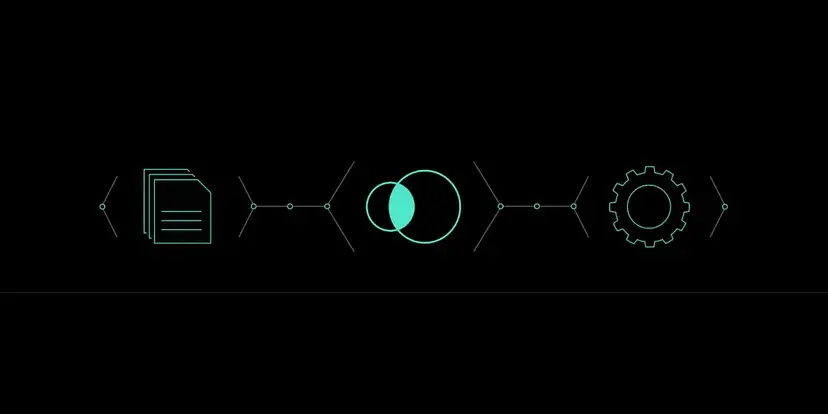
Mathew:
For us, middleware is crucial in bridging Web3 projects with the Web2 environment, merging the user experience of Web2 with the utility of Web3. Smart Layer acts as that intermediary, facilitating a seamless transition between the two worlds. We anticipate operating in a Web2.5 world for the foreseeable future, recognizing the importance of Web2’s persistence. Our role is to enable projects and enterprises to deliver a Web2.5 experience, combining the functionalities of Web3 with the user experience of Web2.
Burnt:
Mathew, we should speak after this; our perspectives are extremely similar. There are two key issues: the first is the fractionalized middle layers in crypto, which lack standardized common core practices, and the second is the need for a Web 2.5 middle layer to bridge to the real world. This challenge is something we tackle daily at Burnt and it’s thrilling for us. I believe we’ll be operating in this Web 2.5 world extensively, and I’m eager to see how others will contribute to achieving this shared objective.
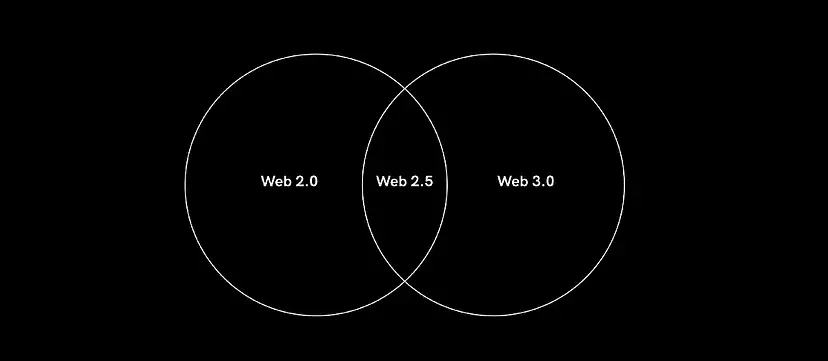
Source: NASSCOM Community
Nicolas:
We’re addressing this challenge in two ways. We first all agree with Mathew and others that there’s a limit to what can be done on-chain. However, we’re committed to finding ways to decentralize operations that can’t be fully managed on-chain to mitigate legal and regulatory overreach stemming from centralization in organizations managing decentralized technologies. This is the primary source of current regulatory pressures.
Second, we’re exploring how to bridge Web2 and Web3 with real-world assets. We aim to create solutions that connect real-world assets or decisions, such as arbitration rulings from the International Chamber of Commerce, with on-chain execution and enforcement. Our goal is to increase the overall decentralization within the space.
Greg:
This is a compelling topic as it highlights the dichotomy in building middleware infrastructure. Many see an API and assume centralization, yet as discussed, for onboarding and mass adoption, we must develop scalable solutions beyond on-chain capabilities, as mentioned with Oracle services and data management.
A future is envisaged where middleware largely consists of off-chain-based computation. It’s crucial to provide verifiable and secure off-chain computation to ensure user safety. As the visions of Cosmos and Polkadot unfold, we may see a shift away from direct interactions with L1 blockchains. The emerging trend favors dual-chain architectures. In these systems, one chain manages value while another handles high-throughput applications, with transactions settled between them
This brings us to a crossroads: How do we balance decentralization? Gaming could be the first sector to demonstrate that a hybrid of decentralized and centralized systems is not only feasible but beneficial, leading to future developments in the field.
Moonshot Commons:
We discussed opportunities and challenges in fraud, middleware, and the evolving space. I’d love to hear how you’re tackling them specifically. What distinguishes your project from others, and can you highlight any unique technical innovations?
Burnt:
We are currently focusing on generalized abstraction. We’re originating from a place where everything is protocol level, aiming to eliminate the complexity of middle layers and competing standards. Looking at the tech stack, we’re breaking it down from user interaction to direct chain interaction. Our technical innovation over the past 18 months has been about integrating everyday payment methods like credit and debit cards on-chain, making gas fees payable in USDC, and enabling signature-agnostic signing among other advancements.
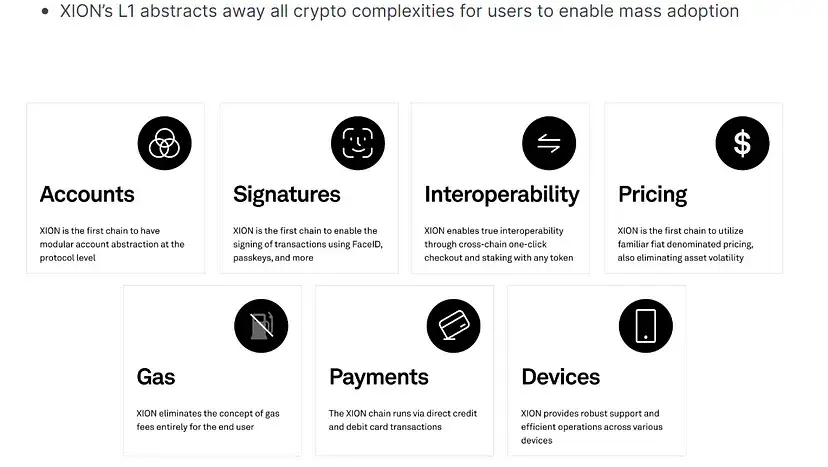
Source: Burnt XION
There’s a lot to cover in this brief update, but I encourage you to look at our documentation for more information on our innovative initiatives. Ultimately, the real innovation comes from what we enable, such as onboarding users with Face ID and allowing transactions to be signed with Face ID right from the protocol level without the associated MEV (Maximal Extractable Value) extraction or security risks, cutting out the middle layer of risk.
Mathew:
Our uniqueness in the market comes from our approach to growth. The Smart Path ecosystem enables any Web2 user to engage with Web3 environments without the concerns of wallets or on-chain transactions, using off-chain tokens and cryptography.
To grow the project, we break down growth elements and integrate them into any part of a user’s experience. This includes incorporating quests directly within the token, making the token interactive, or integrating these elements into any product or user journey.
This approach is omni-channel and supports ecosystem expansion by leveraging insights on users’ activities, levels, and roles to create greater value across the ecosystem. Rather than centralized questing on Smart Pass, it’s about enhancing users’ value by offering a Web2-focused, seamless integration with Apple Wallet or Google Wallet, cross-chain capability, partnerships, and ecosystem growth.
Greg:
Specifically in gaming with Web3 Unity, we focus heavily on building robust failover mechanisms for users. Web3 Unity is modeled after web3.js or Ethers.js as a standalone SDK, meaning you don’t have to depend on a given service for it to function. In building it, we were meticulous about integrations, integrating services like social login or relay so that they don’t rely on us. If we were to disappear, their game should not be interrupted and can be quickly restored with minimal changes.
We support third-party services that share a similar philosophy of independence. We aim for solutions that are permissionless, ensuring continuity even if one infrastructure player disappears. We encourage other teams to adopt this approach, creating products that are self-sufficient to safeguard against the integration challenges in our space, like smart contract audits and high lead times.
We recognize the risk that users could leave, but if the service is good enough, they’ll stay. Our priority is to set people up for success, building not just for ourselves but for the community at large. This approach of empowering users and developers has been working well for us.
Nicolas:
Thank you. We see ourselves as possibly the only ones enabling projects to set complex, discretionary rules and enforce them on-chain in a fully decentralized manner. Disputes arising from these are resolved through the ICC International Court of Arbitration, the world’s largest arbitration court, with outcomes enforced on-chain. This method offers an external anchor for governance security, not reliant on governance tokens alone, which traditionally secure a project similar to trusting bank managers with your money.
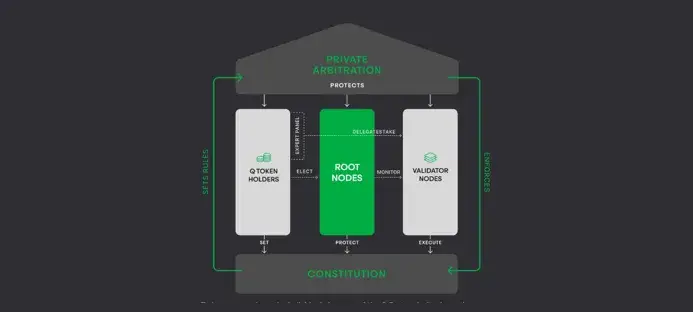
Source: Q Protocol
Our services extend beyond traditional governance by offering external security measures, allowing protocols or projects to have a legal structure that is decentralized and independent of any nation-state jurisdiction. We enable DAOs to make nuanced decisions necessary for sophisticated governance models, such as those needed for life insurance or pensions.
We also stand out by providing decentralized decision-making capabilities for non-binary decisions required in complex governance scenarios. We’re unique in enabling discretionary slashing, not based on simple code logic but rules set by the community, backed by an independent enforcement mechanism we provide.
Zooey:
Dataverse might be the unique data middleware that addresses all three critical aspects of the Web3 data era. Our approach is multidimensional:
Firstly, regarding data storage, our system leverages a combination of decentralized networks. We utilize Filecoin and Arweave for durable backups and the Ceramic Network for decentralized graph database capabilities.
Secondly, data accessibility and permission control are central to our system. We’ve designed a data wallet to safeguard users’ secret keys, which act as the data gatekeepers.
Thirdly and most importantly, we address the origin and generation of data. We’re devoted to incentivizing data production through our comprehensive solution for data monetization. This system is flexible, fully programmable, and developer-friendly.
Our cloud functions as a hyperstorage, providing an isolated data sandbox for each application. Just imagine how each application has its own Dropbox functioning as a cloud database.
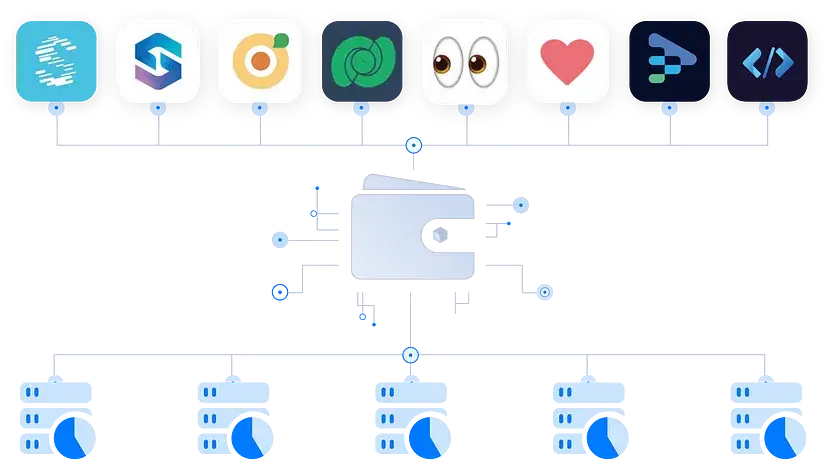
Source: Datavers
Monetization is key when it comes to data ownership and control. Imagine posting content on a social platform and being able to retrieve it from your private data space, just like a local file. Here you can manage and monetize your data. This process involves encrypting the data, transforming it into an on-chain asset, and then selling the access rights. Essentially, one would purchase an NFT as a certificate to unlock the data’s content.
This monetization mechanism means that users don’t just own and control their data; they can also profit from it. Our system encourages people to create data by showing them how they can make money from the information they generate. This is the core of our product offering.
Mark:
What distinguishes Aethir? Consider the challenge of scaling cloud gaming as a case for our decentralized cloud infrastructure. Major tech companies have struggled to extend cloud gaming into developing markets, despite having success in North America and Western Europe. These regions can support the service through subscription costs. However, the irony is that cloud gaming would benefit economically disadvantaged users the most, yet these individuals are often the ones left out.
Aethir has addressed this by successfully scaling our cloud gaming service in regions like Latin America and Southeast Asia. With over 200,000 online gamers in developing markets, our decentralized cloud infrastructure has overcome scalability challenges that legacy tech giants could not, marking a significant point of distinction in our capabilities.

Moonshot Commons:
As we approach the end of the AMA session, let me pose perhaps the most critical question I should have asked from the start. What brought you to the HashKey Demo Day? Who should reach out to you? We’d also appreciate insights into your fundraising efforts and the partnerships your project is actively seeking.
Mark:
HashKey is one of our investors. We value our close work with them and appreciate the invitation. I’ll dive into some of our partnerships to provide context before concluding with an invitation.
At Aethir, we’ve partnered with notable projects, primarily in the gaming sector, as we deploy our cloud gaming infrastructure in Latin America and Southeast Asia. Our partners include Bybit and their Yeeha gaming platform, where we’re cloud-enabling Bybit’s venture into Web3 gaming. We’ve also collaborated with MixMarvel, a Web3 content incubation platform, and gaming portals such as GAM3S.GG, previously known as Polkastarter. These partnerships allow for browser-based gameplay accessible to anyone with an internet connection, without the need for advanced hardware.
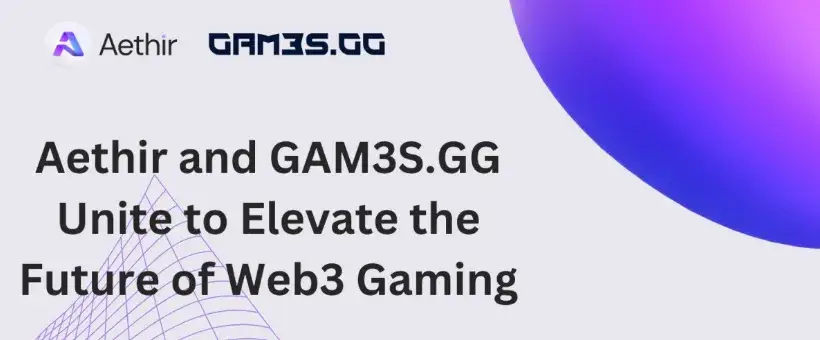
Source: CoinMarketCap
We’re working with Yield Guild Games (YGG) and other gaming guilds on similar initiatives. Additionally, we’re engaging with major Web2 studios on projects that we’re excited to announce soon.
While we’re not currently fundraising, we plan to open a round in December and welcome investor participation. For those interested in the Aethir ecosystem, follow our account for updates on our upcoming token launch at the end of Q1, 2024.
Zooey:
We’re here to explore partnerships and fundraising opportunities, particularly with social protocols for Web3 applications and account solutions like AA (Account Abstraction) wallets or MPC (Multi-Part Computation) wallets to streamline the onboarding of Web2 users.
We’ve recently partnered with Sismo, which offers a ZK (Zero Knowledge) proof-based SSO, and we’re keen on collaborating to develop a trustworthy reputation system. We aim to integrate diverse technologies into our platform.

Source: DoraHacks
We’re also hosting an online hackathon with Phoenix and TLSNotary, called Rebuild Ownership 2.0, available on DoraHacks. Phoenix leverages fully homomorphic encryption, while TLSNotary combines TLS protocols with multi-party computation for private data’s selective disclosure, and Tableland offers a decentralized database. We are mainly looking for data infrastructure and cryptographic tools. If your project aligns with these, we’re open to discussing potential collaborations in market technology or products.
Greg:
We’re on the lookout for those interested in expanding into interoperability or the gaming sector, particularly Unity developers. If you have developers eager to create in this space, that’s our target. Short and sweet — thanks for having us back.
Mathew:
What brings us here today is the support from HashKey, our investor — thank you for that. We’re currently seeking Web3 projects interested in innovative growth strategies. Our Smart Pass, a new offering from Smart Layer, has successfully expanded our community by over two million in four months through onboarding and questing features designed for user growth. If you’re curious and looking to adopt this technology, drop us a direct message to explore a partnership.
Burnt:
We’re deeply appreciative of HashKey, our early investor, for their support. For users interested in what we’re developing, our test net is available for you to explore. Developers will find a robust and growing ecosystem with over 75 partners and 15 native projects already integrating with our test net. We’ll be launching a campaign on this soon.
On the infrastructure side, we’ve partnered with major Web2 services like Stripe, Checkout, and Stitch to enhance the user experience. We’re open to discussions to further strengthen our infrastructure and provide the best possible experience for our users. We’re truly delighted to be here and to share our message with all of you.
Nicolas:
Thank you to HashKey for hosting us. We’re currently expanding our ecosystem, particularly among partners and projects that leverage the robust governance features we offer. There’s been significant demand from DeFi projects and DAOs seeking to safeguard their treasuries and implement code upgrades without admin keys.
We achieved regulatory clearance in Germany and Liechtenstein two years ago, affirming our expertise in these areas. We’ve also seen positive responses to our liquid staking solutions and are looking for projects to support reducing centralization risks.
We are also in an active fundraising phase. If you are interested in us and want to dive deeper, you can learn more at q.org, our website. We aim to enlarge our community as we gear up for a token launch slated for next year.
